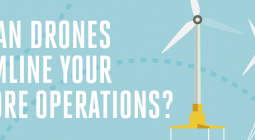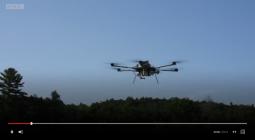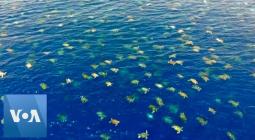Eyes in the sky: why drones are ‘beyond effective’ for animal rights campaigners around the world
Inexpensive and easy to use, drones are proving invaluable for activists monitoring illegal fishing, hunting and deforestation – as well as keeping tabs on zoos and aquariums
Late last year, UrgentSeas received an anonymous tip from a former employee at the Miami Seaquarium about animal tanks away from public view. The advocacy group went to investigate.
In November, they posted a short clip of what they found by flying a drone over the property: an elderly manatee living alone in a decaying private pool. Within a month, the clip had been watched millions of times and the outcry had grown so intense that the US Fish and Wildlife Service moved the manatee, Romeo, and his mate, Juliet, to a sanctuary.
Over the past decade, drones have become irreplaceable tools in activist and conservation circles. In 2013, the animal rights group Peta (People for the Ethical Treatment of Animals) launched a drone campaign tracking illegal bowhunting in Massachusetts.
Since then, drones have been used to record factory farm pollution in the American midwest, sea lice outbreaks in Icelandic salmon pens, and deforestation in the Brazilian Amazon. Drones are popular because they’re relatively cheap, easy to use and extend a person’s range in difficult or inaccessible terrain. They also provide a bird’s-eye view of the scale of an issue, such as an oil spill or illegal logging.
When it comes to marine mammal captivity, the aerial perspective can be invaluable, exposing the cramped conditions and the constrained life for the animals inside the tanks.
In some cases, the drones capture the secret lives of animals hidden from view, such as Romeo the manatee in Miami. “This is the footage people need to see to realise how cruel captivity really is,” says the drone pilot who shot the footage at the Miami Seaquarium, and who prefers to remain anonymous.
Another early adopter of drones is Sea Shepherd. The marine conservation group started filming illegal, unreported and unregulated (IUU) fishing in international waters. As technology improved, drones have become quieter and stealthier, says Simon Ager, a longtime volunteer with Sea Shepherd. This is critical for sneaking up on ships and capturing crimes in progress, he adds.
“In my experience, drones have been beyond effective because you can never get close enough to a ship that’s got some illegal activity going on. They spot us coming and then they’ll just turn and burn, over the horizon, and you’ve got nothing to go after these guys,” Ager says.
Off Mexico and Ecuador, Ager recorded tuna fishers pulling up nets tangled with unintentional bycatch, such as sharks, and dumping miles of fishing line in the water, which snags and kills more marine life. Off the Galápagos Islands, he tracked a vast fleet of Chinese squid-fishing ships with a night-vision drone. That campaign exposed rampant environmental and human rights abuse on board, including slave labour and the dumping of unwanted catch.
Drones also allow activists to safely distance themselves from the risky situations they’re filming. During one campaign to save the critically endangered vaquita porpoise in the Gulf of California, cartel-funded fishers shot Sea Shepherd’s drones out of the sky and hurled molotov cocktails at their ship.
“Conservation can be a very dangerous occupation to be in and there are more environmentalists killed every year,” says Ager. “Drones are a perfect way to study something without putting yourself in harm’s way and then decide whether it’s worth the risk.”
The high seas are a largely lawless frontier where rules and regulations are flagrantly broken. It’s a different legal landscape on land, where activists use drones to film zoos and aquariums. The UrgentSeas pilot says that she uses an app to determine where drones are permitted and tries her best to follow the appropriate laws.
“Flying these drones, you don’t do it obviously,” she says. “You don’t go and stand outside the facility and send your drone over. You hide in a bush sometimes. You watch for cars. It’s kind of like a mission.”
After the drone footage of Romeo went viral last November, the Miami Seaquarium filed for a protective order against Phil Demers, the co-founder of UrgentSeas. The move was part of a larger lawsuit the aquarium filed against the animal activist in May 2023, alleging defamation, public nuisance and trespassing – much of it by flying drones and recording the property.
The Miami Seaquarium did not respond to several requests from the Guardian for comment but has said in the legal complaint that Demers “has repeatedly, and without authorisation, flown an unmanned aerial vehicle over [Seaquarium’s] property during regular business hours”.
As a relatively new technology, drones still exist in a legal grey area. “The question of drones, laws and privacy is a new question,” says Benjamin Christopher Carraway, a lawyer at the Animal Activist Legal Defense Project in Colorado and Demers’s attorney. There are a few state torts and statutes regarding drones, but he hasn’t seen much case law work its way through the courts yet.
Activists argue that drones are necessary for free speech and democracy, but opponents say that they infringe on privacy and, in the case of aquariums and zoos, disturb animals, customers and staff.
Carraway hopes that any drone laws will treat the conflicting concerns in a nuanced way. “The whole concept of drones requires a lot of updating in the law and it begs this other question, which is the balancing of privacy, which is a legitimate interest versus the public’s right to know.”
The trial involving Demers and the Miami Seaquarium is set for May, but it’s doubtful the facility will still be in business by then. The death of the orca Lolita last year and the report of the living conditions faced by Romeo have ratcheted up public pressure on the already beleaguered aquarium. On 7 March, Miami-Dade county issued an eviction notice, ordering the aquarium’s operator to vacate the county-owned property by 21 April.
“The Dolphin Company has repeatedly fallen short of meeting the contractual obligations of their lease,” said the Miami-Dade county mayor Daniella Levine Cava. “From failing to maintain the premises in good condition, to failing to demonstrate that they can ensure the safety and wellbeing of the animals under their care, the current state of the Miami Seaquarium is unsustainable and unsafe.”
Every month, UrgentSeas receives five or six tips from whistleblowers, most of whom are former or current staff at zoos and aquariums around the world. According to Whale & Dolphin Conservation USA, there are now 56 orcas in captivity globally.
UrgentSeas plans to document every facility by drone (though the group discourages supporters from flying drones themselves). “It’s the drones that can show you everything,” says the anonymous UrgentSeas pilot. “But it comes with a lot of risks.”
Cover photo: A Sea Shepherd thermal drone monitors the vaquita refuge in the Gulf of California, in an operation to protect the world’s most endangered marine mammal from illegal fishing. Photograph: Eli Hausman/Sea Shepherd Conservation Society





